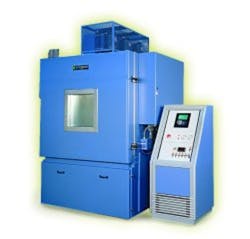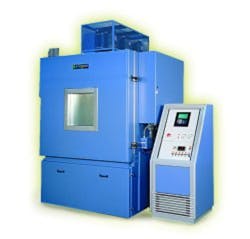Highly accelerated life testing (HALT) relies on the principal of logarithmic time compression to simulate a product’s entire life in just a few days. The test sequence provides every life-threatening stimulus that the product is likely to encounter. Generally, it includes temperature cycling at high rates, vibrating in all axes, operating voltage variations, and changing clock frequency.
The HALT sequence for a product starts with all of its small subassemblies and continues to the full system implementation. Tests go on until the subassembly or product destructs. Then, the results are fed back to engineering for correction of design problems and to vendors for improvement of component quality.
HALT still is an emerging technology, but one that is being studied in incredible detail. The tests themselves are fairly well defined, but test specialists are working to determine the degree and type of stress that equate to each 1,000 hours of normal usage. The answer will be unique for each product and application since the rate of aging is a direct function of its design and the environment in which it is used.
Gregg K. Hobbs, president of Hobbs Engineering, who coined the HALT acronym, presented several HALT cost-saving benefits:
- Product design time is reduced because design weaknesses are discovered much earlier and fixes can be implemented and verified sooner.
- Fabrication costs are lower because HALT results are fed back into a highly accelerated stress screening (HASS) program.
- Warranty repair costs are much less because the delivered products are fault-tolerant.
- The increased product reliability could bring higher sales.
The HALT missionaries are at work. More and more companies realize the benefits of their own HALT programs and require or encourage their suppliers to implement similar testing.
Definition of a HALT Program
For a HALT program to provide maximum benefits, a definite plan must be developed at the beginning of the design process and approved by those responsible for implementing, using, and paying for the tests. The company’s quality, reliability, and environmental test engineers should be involved in developing the plan. Probably a representative of the environmental test equipment manufacturing firm should be there as well as a specialist from an experienced HALT consulting firm.
The program plan will be the reference book for everyone so it must be thorough and include some theory. It will outline the objectives of the test sequence, define terms, and list some references. Also, this is the place to specify the reporting format.
Choosing a Test System
Developing a Stress Profile
In the initiation of HALT, you must establish a test profile—a definition of the types of environment to which the product will be exposed, the level of each, and the steps of severity. Merely testing a product to withstand the worst conditions expected in the field does not ensure reliability. It needs to be designed with a safety margin. To do this, it is necessary to determine the operational limits of each element of the product. The profile is the engineer’s tool for this exploration.
“The HALT profile is based on step-stress testing using appropriate stresses until the fundamental limit of the technology is reached,” said Mr. Hobbs of Hobbs Engineering. “When faults are observed, the failure mode and mechanism are considered, but not the stress type, level, and margin.” He noted that, due to the crossover effect, HALT will uncover a design or process weakness even though it may use different stresses than those that would uncover the same weakness in the field.
There is no standard HALT profile. However, Chris Scholten, an applications engineer at Thermotron Industries, explained, “A typical profile starts with cold-step testing with 5°C to 10°C steps, then moves on to hot steps of similar magnitude. This step-testing is followed with extremely fast temperature transitions. Next comes vibration in ever-increasing steps. Finally, a combined temperature/vibration environment is imposed on the product. To catch soft failures as well as hard failures, it is imperative that each product be monitored constantly during the HALT sequence.”
Some Examples
One company used HALT to investigate problems with several large telecommunications cards, according to Gil Bastien, a senior member of the technical staff and a HALT/HASS specialist at Screening Systems. Various design weaknesses were discovered, which led to product redesign.
However, the biggest surprise came with the discovery that disk drives from two different sources performed very differently during HALT. One was capable of only 0.5g rms vibration while the other operated well at 10g rms. This led to disqualification of what had been assumed to be a logical second-source drive.
Eric Peterson is the product reliability manager at Digital Lightwave, a producer of fiber-optic network test equipment. “HALT is a Digital Lightwave program not driven by any outside force,” he said. “We develop a profile for each subassembly and the overall system, studying each item carefully and relying on past experience as we select profiles. Most failures are pretty predictable, and HALT merely confirms what we could have suspected from study and experience.
“Occasionally we get a shocker,” he continued. “The surprises are the things that make HALT so valuable to us.
“Our customers know that we perform HALT on our products, but probably that is not a selling point with them. They just want reliability, and the fact that HALT is one of the things that improves the product is coincidental,” Mr. Peterson concluded.
At the professional testing laboratories, virtually no customer has a detailed definition of what type of HALT program should be performed on a product. Instead, the manufacturer and laboratory personnel work together, drawing on the design engineer’s knowledge of the product and the laboratory’s experience with testing.
Generally, they agree to start with a modest vibration and temperature change, possibly 10g or less and 30°C/min. The laboratory personnel run the tests in the -40°C to 100°C range, inspecting the product continually. If the first levels of severity don’t precipitate any failures, the amplitude and frequency of vibration and the rate of temperature change are increased. At some point, the tests begin to uncover defects.
“One customer had a problem that seemed to be related to soldering quality,” said Ron Ryniewicz, manager of the testing laboratory at ESTL-II. “Knowing this, we conducted a vibration-only HALT with a tailored profile that concentrated on an area on the PCB that had some large unsupported components.
“Instead of operating the product during the test, we inspected solder joints under a microscope to verify that defects really were being uncovered. The customer then conducted metallurgical tests on the bad joints, confirmed the problem, and initiated corrections,” he explained.
HALT for Military Radios
We tend to think of military radios as being extremely rugged—and they are. However, a company that designs and develops these products found that a well-designed HALT was able to locate defects quickly.
Because Raytheon had seen the benefits on other product developments, the company chose to initiate HALT several years ago on a government contract for radio equipment. It was not required, but experience had shown that these tests would accelerate the development cycle and enhance the quality of the product.
Bruce McAfee, a HALT program manager at Raytheon, reported, “We ran HALT on a radio set, found a defect, and started corrective action. The same defect showed up later on the customer-witnessed environmental tests, and we informed the procurement engineers that we already had discovered the problem and were working on a solution. Even though the procurement contract didn’t require HALT, the government representatives were extremely happy with our results.”
The HALT profile at Raytheon was determined by a study of the assembly or subassembly, then application of some of the things that the company has learned from experience. No two radios have the same profile. They usually start with the maximum vibration that the vibration equipment will supply and then run the temperature to about 20°C beyond the expected environmental extremes.
One eye-opener was learning that HALT could catch problems at the individual PCB. This in itself has been a tremendous help in accelerating the development cycle. Mr. McAfee reported that Raytheon tests each PCB as the prototype is ready and goes to work on the fixes before other subassemblies are designed.
“Sure, HALT catches the simple things that we might have discovered on our own,” he continued. “Most importantly, it uncovers a few surprises. For example, we assume that every chip is fabricated properly, but in some cases, we learn differently. We could study a product to death without discovering that kind of defect. That’s the way HALT pays for itself.
“A HALT sequence on a PCB generally takes one day. We don’t know how much life is compressed into that few hours. However, we found a 1,000:1 time compression when we compared a conventional environmental test to a HALT sequence in uncovering a defective internal bonding wire on one of our products,” Mr. McAfee said.
Testing Computer-Based Equipment
Ronald Horrell, a manager of reliability engineering at Hamilton Standard, is absolutely sold on HALT. “We started HALT about five years ago on our computer-based products for the aerospace industry. It was suggested by one of our customers, Boeing, as an alternative to an accelerated life test program,” Mr. Horrell said. “When we looked into it, we found that it was likely to be a money saver. This has proven to be the case. In fact, our top management is very much aware of the large savings that the program offers. For example, on one product we found more defects in one week of HALT than on 40 weeks of accelerated life tests.
“We perform similar steps of stress on each product and keep raising the stress levels until it stops working. We are limited in the maximum stress that we can apply by our test equipment, but generally we can carry a product to the failure point,” he continued.
“Mr. Hobbs has been a strong influence in our HALT program,” Mr. Horrell reported. “I have attended his courses and sent several of my staff to the training.”
Some of the Hamilton Standard customers understand HALT and thoroughly appreciate what the company is doing. Others, especially military customers, are not as familiar, and it’s a whole new way of thinking for them.
Also, Hamilton Standard found that a life test several months long is hard to monitor. Who wants to wait nine months for a solder joint to fail? The engineers found that 95% to 98% of all anomalies were test instrument-related, not product failures.
Will We See Specifications? Guidelines?
At the IEEE/CPMT 2000 Workshop on Accelerated Stress Screening, Ms. Baker of Screening Systems noted that workshop leaders got into a spirited debate regarding the establishment of IEEE specifications or guidelines for HALT and HASS. Many practitioners cringe at the suggestion that people might use the same screening for dissimilar products.
For example, this happened a few years ago when the U.S. Navy established guidelines for stress screening. Later Navy engineers found that many contractors and government monitors misunderstood the intent and had accepted the guidelines as absolute directives. Some products were being overscreened and others underscreened, simply because of a misunderstanding about terminology.
Will this happen with HALT? The experts hope not.
Published by EE-Evaluation Engineering
All contents © 2001 Nelson Publishing Inc.
No reprint, distribution, or reuse in any medium is permitted
without the express written consent of the publisher.
March 2001


